THE VENICE CRONORAMA
Rivus Altus in 10 years 2013 – 2023
La Fenice – variation #14
XL66 224,8×95,6 cm
Technique: Giclèe Fine Art Print, Transparent Plexiglas® + White Plexiglas® Floating fragments, Aluminum frame, 2024. Unique work.
Aqua Granda – variation #12
M78 177,7×68,4 cm / XS78 121,5×49,3 cm
Technique: Giclèe Fine Art Print, Transparent Plexiglas® + White Plexiglas® Floating fragments, Aluminum frame, 2024. Unique work.
Rosso Veneziano – variation #17
XL24 96×95,6 cm / M24 68,8×68,4 cm / XS24 49×49,3 cm
Technique: Giclèe Fine Art Print, Transparent Plexiglas® + White Plexiglas® Floating fragments, Aluminum frame, 2024. Unique work.
Serenissima – variation #13
XL24 96×95,6 cm / M24 68,8×68,4 cm / XS24 49×49,3 cm
Technique: Giclèe Fine Art Print, Transparent Plexiglas® + White Plexiglas® Floating fragments, Aluminum frame, 2024. Unique work.
Casanova – variation #11
XL24 96×95,6 cm / M24 68,8×68,4 cm / XS24 49×49,3 cm
Technique: Giclèe Fine Art Print, Transparent Plexiglas® + White Plexiglas® Floating fragments, Aluminum frame, 2024. Unique work.
Bucintoro – variation #18
M78 177,7×68,4 cm / XS78 121,5×49,3 cm
Technique: Giclèe Fine Art Print, Transparent Plexiglas® + White Plexiglas® Floating fragments, Aluminum frame, 2024. Unique work.
Arlecchino – variation #15
M78 177,7×68,4 cm / XS78 121,5×49,3 cm
Technique: Giclèe Fine Art Print, Transparent Plexiglas® + White Plexiglas® Floating fragments, Aluminum frame, 2024. Unique work.
THE NEW YORK CRONORAMA 04
Times Square in 60 hours
Extending this approach, Farina’s Cronorama series continues in New York, where he first observes Brooklyn before moving to the vibrant chaos of Times Square. Known for its neon billboards and constant flow of people, this iconic location provides a stark contrast to the quiet contemplation of Venice. Farina’s observations of Times Square offer a fragmented, dynamic perspective, where the crowd and the overwhelming visual noise of advertisements collide, revealing the underlying rhythms of urban life in this bustling metropolis.
Times Square – variation M#05
Technique: Giclèe Fine Art Print, Plexiglas® Hard Coated, Aluminum frame, 2021. Unique work.
THE MILANO
CRONORAMA 03
la Madonnina in 120 hours
The Venice Cronorama by Max Farina
60.557 fragments, over 500 hours of observation from 2013 to 2023, more than 16.000 people portrayed.
These are the numbers of the project that represents a true visual “attempt of exhaustion” of the most photographed, painted, and known Venetian panorama in the world: the view from the Rialto Bridge and the incessant flow of people who, in turn, observe it. In 10 years, the photographer recorded every change in the panorama, focusing on the individual fragmentation that makes up the landscape. Over 10.000 shots similar to puzzles, the images no longer capture a specific moment but become a perspective traced by the passing of the time. The portraits of the crowd transiting the Rialto Bridge, captured in black and white while admiring the panorama, represent a contemporary “Caravanserraglio”. In this research, Max Farina drew inspiration from the text of the French writer Georges Perec, “Tentative d’épuisement d’un lieu parisien” (Paris, 1975), in which the author explores a square in the City of Light from different points of view and at different times, noting every variation. In Rivus Altus, like Perec, Max Farina does not follow, investigate, or narrate. He lets the camera record what happens, even when nothing happens. He “shatters the stereotype of Venice” to propose a kind of “machine à voir” that invites us to see the Grand Canal as if through a magnifying glass scrutinizing its smallest details made of light and darkness, water and skies, buildings and boats, crowds, and silences…
The Cronorama Serie
Max Farina adopted a fragmented vision, creating a series of visual exhaustion photographic projects called Cronorama. For over ten years, through this unique practice and relentless visual surveillance, he observed cities while standing still in the same observation point. The Cronorama captures intricate details that often go unnoticed, revealing the hidden poetry in urban chaos. These time capsules preserve ever-evolving urban landscapes, offering a new perspective on the essence of each city. Time transforms this work into an organic, never-finished piece that continues to enrich itself. Max Farina creates works in progress, adding new photographs through new viewpoints and using new techniques; this is how he makes his work a constant work in progress. Max Farina is also developing the Cronorama project in New York with works from Times Square and Brooklyn, in his hometown Milan, photographing the cityscape from the Madonnina of the Duomo, in Paris, Los Angeles, and many other cities, always seeking new and iconic perspectives.
Born in Milan in 1974, he graduated in architecture from the Polytechnic University of Milan. Since 1991, he has been dedicated to reportage photography, architecture, and documentation of the territory, collaborating both on commission and on personal artistic projects. Max Farina has always explored the visual impact of the passage of time on iconic, architectural, and landscape perspectives. He has adopted a fragmented vision, creating a series of photographic projects on “visual exhaustion” called “Cronorami,” a neologism he coined. For over 10 years, through this unique practice and numerous visual observations, he has studied cities that remain still in the same place. In 2016, he organized the first solo exhibition of Rivus Altus at the Don Orione Artigianelli space, at the Zattere, during the 15th Architecture Biennale, receiving significant recognition.
































